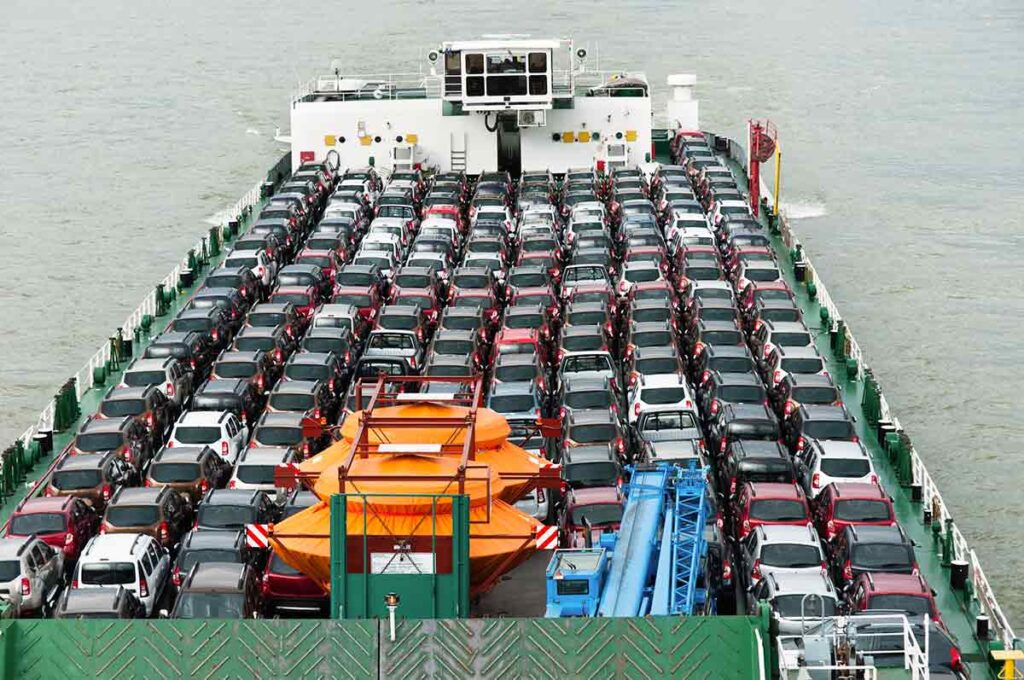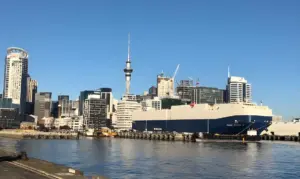
Did you know that Coastal Container Shipping can save around 50% on freight costs?
Coastal Shipping can also limit damage to your vehicle and provide a great alternative for over-dimensional freight.
A handy alternative to road transport for your overweight electric car or tricked out 4WD.
What is Coastal Shipping in Australia?
Also called short-sea shipping, coastal shipping is the movement of cargo by ship along the coast of a continent, without crossing an ocean.
For Australia, coastal shipping includes international or Australian flagged vessels travelling from the eastern seaboard of Australia to Western Australia, as well as goods moving across Bass Strait via dedicated Australian flagged vessels.
Coastal shipping in Australia is serviced by foreign and Australian vessels that provide international services for import and exports. Shipping goods to and from Australia (typically from Asian ports).
While the primary purpose of these vessels is international cargo, they can carry cargo between Australian ports as a way of supplementing their income.
Given that the vessels are usually scheduled to call in at most Australian ports as part of their international schedules. The cost of the coastal service for local logistics can be far lower than that cost provided by shipping with a dedicated vessel.
Why Coastal Vehicle Shipping is an Affordable Transport Option
In Australia, logistics flows are in strongest demand from East to West. Transporting anything from the eastern seaboard (Melbourne, Sydney and Brisbane) to Perth tends to be harder to book than the return journey.
Basically, there is insufficient demand for goods from Perth to fill a regular vessel, so ships would essentially travel back to the East relatively empty.
As a result, a dedicated coastal shipping service in Australia would have to subsidise a trip from Western Australia by revenue earned from the cargo shipped from the East to the West.
For the same reason both rail and road transport companies heavily discount their prices from West to East transits, compared to their in-demand services from the East to the West.
With this unbalanced demand for coastal shipping, the use of international ships to transport cargo oneway as they make their way around the bottom of Australia is ideal for providing competitively priced transport services for non-time critical cargo.
The Advantages of Using Coastal Shipping for Vehicle Transport
When comparing rail or road transportation to coastal shipping for vehicle transport there are a number of key benefits.
The Cost of Coastal Shipping
The main reason why customers prefer to use sea freight over road and rail is the cost of the door to door service.
Unlike rail, sea freight by container is charged at the same price per unit (container) regardless of the tonnage packed.
Rail services charge an incremental tonnage over and above the base unit rate for a container (i.e. the heavier your cargo the higher the freight charge). As a result, coastal shipping can offer customers cost savings of 40-50%.
Even greater savings of 60-65% are achievable when compared to line haul services by road from eastern Australia to Western Australia.
Coastal Shipping is Great for Damage Mitigation
Some customers find that their cargo is not suitable for rail transport because of the shunting involved and the constant movement back and forth that is unique to rail transport. Owners of motorhomes and vintage cars in particular find shunting to be worrisome.
For example, some customers in the construction industry will choose to ship fragile products such as plasterboard by sea rather than via rail to limit potential damages to their products.
While shipping can get rough when the weather closes in, it is generally a more gentle rolling movement rather than constant abrupt movements back and forth.
Coastal Shipping Accommodates Over Dimensional Cargo
The requirements for rail cargo to be either containerised or loaded into rail wagons, can be limiting for over dimensional cargo.
In Australia the rail network does not permit over sized cargo on the rail system due to the fixed width of the rails paths and height of bridges.
That means that very heavy or over dimensional cargo can usually only be transported by road or ship in Australia.
Fortunately there are coastal shipping services to Perth, from the eastern states, that specialise in cargo that cannot be containerised (because it is over dimensional). This cargo can be loaded onto vessels by crane or towed on to the deck of vessels with special equipment.
Cargo up to 5 metres high and wider than a standard truck can be effectively loaded on a vessel and transported via sea generally at a far lower cost compared to the road service. So transporting trucks and buses can be easily done by sea.
In some cases, this over dimensional transport process via sea is less restrictive in terms of not having to get escorts and over dimensional permits for long-haul transport by road (avoiding the challenges of each state and territory jurisdiction requiring different permits and road access restrictions).
Coastal Shipping Means Constant Transit
Transporting cargo by road when it is over-dimensional or over-weight limits travel to daylight hours only.
By ship, your vehicle travels non-stop through the night.
What are The Trade-offs with Shipping by Sea?
Australia is a vast country, so we’re used to the long distances that must be travelled to get from one side of the country to the other.
We also understand that those long distances, means it takes a long time to get to your destination.
Can Have Longer Transit Times
The most significant trade-off associated with shipping by sea versus transport by rail or road is the longer transit times.
For example, sailing from Sydney to Perth takes approximately one week, and the customer also needs to allow several days either side of that week to lodge that cargo onto the origin wharf in anticipation of the ship’s arrival. As well as to transport the cargo off the receiving wharf and out to the waiting customer at the destination end.
The average door to door transit time for coastal shipping from the eastern seaboard to Perth is approximately 10-14 days.
Transit time for rail is approximately 1 week while road is between 2 and 4 working days depending upon the service requested.
For time critical transport the additional week for sea compared to rail can be unacceptable to some customers. Waiting 2 weeks for your 4-wheel drive to arrive for the start of your driving holiday is probably unreasonable.
Weather Has Been Known to Cause Delays
Just like the ‘Cricket’, coastal shipping can be impacted by the weather.
Unlike rail which departs daily at a scheduled time, coastal shipping may only depart subject to weather conditions (this might be once a week) or schedule changes due to international shipping operations.
As we know from major flooding and fire events in recent years, road transport can also be severally affected by the weather here in Australia. Delays extending from days to months caused by damages to roads and bridges.
We advise customers to take into account that actual transit times can extend beyond the normal 10-14 days due to delays associated with these factors, potentially resulting in actual transit times that may extend by at least a week on some rare occasions.
Coastal Shipping Your Vehicle
Interested to know more? Speak to JCS Global about a quote for coastal vehicle shipping to move your vehicle across Australia, or get yourself a quote online.
When comparing quotes, consider your personal situation. The team at JCS Global have years of experience with challenging vehicle moves and can help you get your car, truck, van, bus or motorhome shipped safely and within budget.
Ask us how. Call 1300 404 579





